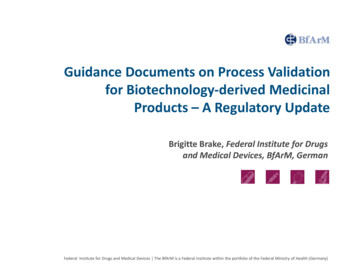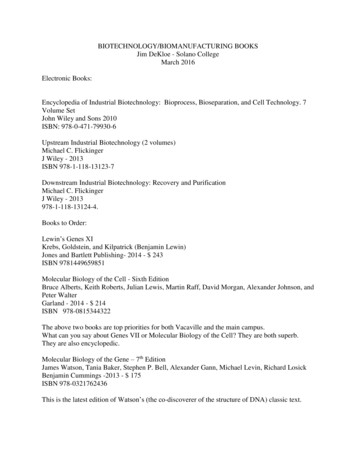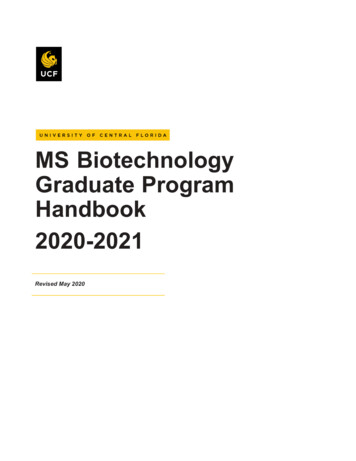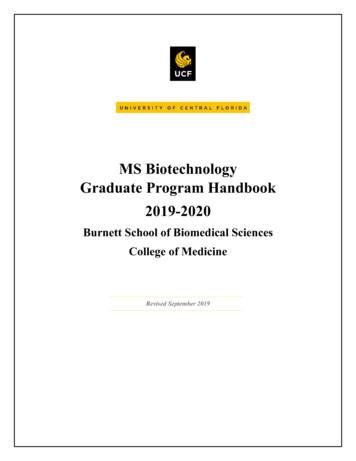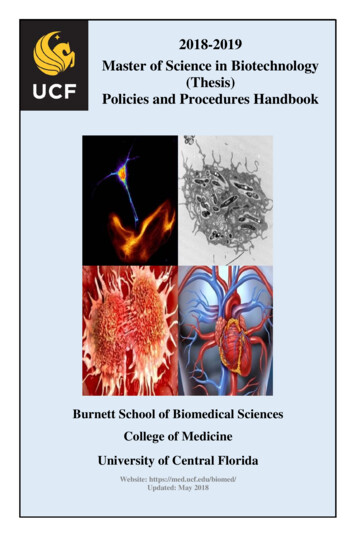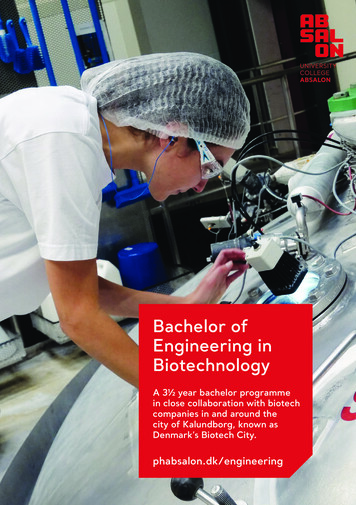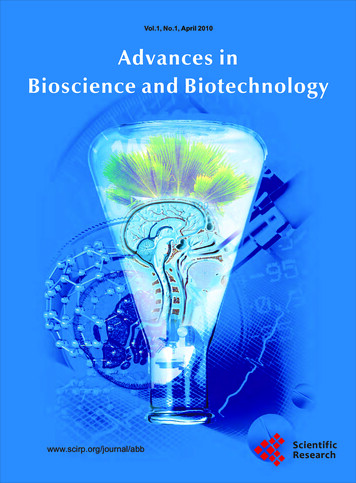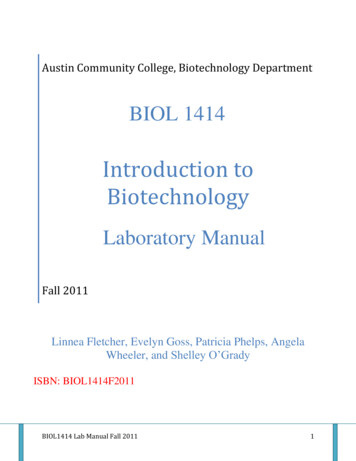
Transcription
Austin Community College, Biotechnology DepartmentBIOL 1414Introduction toBiotechnologyLaboratory ManualFall 2011Linnea Fletcher, Evelyn Goss, Patricia Phelps, AngelaWheeler, and Shelley O‘GradyISBN: BIOL1414F2011BIOL1414 Lab Manual Fall 20111
BIOL1414 Lab Manual Fall 20112
Table of ContentsLAB UNIT 1: INTRODUCTION TO BIOL1414 LAB . 5Lab Unit 1-A: Documentation: The Lab Notebook & Lab Report . 11Lab Unit 1-B: Biotechnology Laboratory Security & Safety . 17Lab Unit 1-C: Lab Equipment & Reagent Orientation. 25Lab Unit 1-D: Math Skills for the Laboratory. 31LAB UNIT 2: CURRENT GOOD MANUFACTURING PRACTICES (cGMP) . 39LAB UNIT 3: BASIC TOOLS IN THE BIOTECHNOLOGY LABORATORY . 85Lab Unit 3-A: Using a Micropipette. 91Lab Unit 3-B: Calibrating Lab Instruments . 97LAB UNIT 4: PREPARING SOLUTIONS . 103LAB UNIT 5: TOTAL RNA ISOLATION FROM ALFALFA SPROUTS . 115Lab Unit 5-A: Total RNA Isolation . 121Lab Unit 5-B: Denaturing Gel Electrophoresis of Total RNA . 123LAB UNIT 6: TRANSFORMATION OF E. coli WITH A RECOMBINANT PLASMID . 127LAB UNIT 7: PLASMID ISOLATION . 135LAB UNIT 8: RESTRICTION ENZYME MAPPING . 141LAB UNIT 9: GREEN FLUORESCENT PROTEIN PURIFICATION . 151LAB UNIT 10: SDS-PAGE OF PURIFIED GFP . 159LAB UNIT 11: PCR-based VNTR Human DNA Typing . 169Lab Unit 11-A: Isolating DNA & PCR of VNTR Loci . 171Lab Unit 11-B: Analysis of VNTR loci PCR Fragments Using Agarose Gel Electrophoresis175LAB UNIT 12: BIOREMEDIATION . 179LAB UNIT 13 – DNA FINGERPRINTING BY SOUTHERN BLOT ANALYSIS . 185Lab Unit 13-A: Electrophoresis & Transfer DNA . 187Lab Unit 13-B: Colorimetric Detection of DNA . 191LAB UNIT 14 – INDIRECT ELISA FOR HIV-1 DETECTION . 195LAB UNIT 15 – MINING BIOLOGICAL DATABASES ON THE INTERNET . 203Lab Unit 15-A: Hemoglobin Bioinformatics. 207Lab Unit 15-B: Bioinformatics Translation Exercise . 219BIOL1414 Lab Manual Fall 20113
Lab Unit 15-C: Finding Mutant Sequences . 227APPENDIX . 229Appendix A: Safety Training Sheet . 231Appendix B: Sample Pre-Lab . 237Appendix C: Forms . 239Appendix D: Graphing Data . 245Appendix E: Summary of Good Laboratory Practices . 249Appendix F: Agarose Gel Electrophoresis with SYBR Green . 253BIOL1414 Lab Manual Fall 20114
LAB UNIT 1: INTRODUCTION TO BIOL1414 LABWelcome to your first course in biotechnology! This course will emphasize its laboratorycomponent to reflect the importance of your training in biotechnology skills. Keep in mind asyou work your way through this manual the specific purposes in each exercise. They willprepare you for your first job in a biotechnology laboratory, so keep a careful record of yourexperience. If you carefully document and archive your work, this information will be easy foryou to access later and your experiences will be more valuable in your later work.The objectives of the lab portion of the course are to:o Develop the basic laboratory techniques of a biotechnology or bioscience labo Supplement and enrich the lecture portion of the course, which deals predominantly withbiotechnology techniqueso Develop critical thinking skills in the studentso Encourage teamwork and accountability among the studentso Practice accuracy in calculations and in writing scientificallyo Develop multitasking skillso Encourage students to take charge of their learningo Learn the responsibilities associated with working in a companyStudents are expected to behave professionally at all times. Lab notebooks will be maintainedand graded in the lab. The lecture will provide background and relevant information about thesolutions, prep, procedure and related techniques.Required Texts/MaterialsTextbooks:Seidman & Moore, Basic Laboratory Methods for Biotechnology: Textbook &Laboratory Reference, 2nd edition. 2009. Prentice Hall. ISBN: 0321570146Lab Manual: ―BIOL1414 Introduction to Biotechnology Laboratory Manual‖ One copy of the labmanual will be supplied.Supplies:3 Ring Binder (Lab notebook), Scientific Calculator with statistics and linear regressioncapability, Sharpie labeling pens (fine tip).Lab Safety:Safety glasses with a rating of Z87 and close-toed shoesBefore you can begin working in an ACC laboratory, you must first1. View the ACC Science Safety video.2. Tour the laboratory with your laboratory instructor to locate emergency equipment andprocedures.3. Sign a safety contract, by which you agree to comply with safety regulations.We hope that you enjoy your experience in this introductory course. Following is a discussion ofbiotechnology, and a description of some of the activities that you will be doing in this course.BIOL1414 Lab Manual Fall 20115
What is biotechnology?Strictly speaking, biotechnology is the use of a living organism for one‘s own benefit. By thisdefinition, biotechnology would date back to the very beginnings of civilization, whenhumankind first learned to cultivate crops and domesticate animals in a system of agriculture.When one thinks of modern biotechnology, however, gene splicing and recombinant organismstake center stage. Biotechnology was revolutionized when scientists first learned how to isolateand clone genes, allowing for genetic engineering.Today, the biotechnology industry has grown and expanded to affect us on a day-to-day basis.Below is an excerpt from Bio.org that discusses the ever expanding applications ofBiotechnology in healthcare, agriculture and energy (http://www.bio.org/about biotech/).Biotechnology: Healing, Fueling, and Feeding the WorldAt its simplest, biotechnology is technology based on biology - biotechnology harnesses cellularand biomolecular processes to develop technologies and products that help improve our lives andthe health of our planet. We have used the biological processes of microorganisms for more than6,000 years to make useful food products, such as bread and cheese, and to preserve dairyproducts.Modern biotechnology provides breakthrough products and technologies to combat debilitatingand rare diseases, reduce our environmental footprint, feed the hungry, use less and cleanerenergy, and have safer, cleaner and more efficient industrial manufacturing processes.Currently, there are more than 250 biotechnology health care products and vaccines available topatients, many for previously untreatable diseases. More than 13.3 million farmers around theworld use agricultural biotechnology to increase yields, prevent damage from insects and pestsand reduce farming's impact on the environment. And more than 50 biorefineries are being builtacross North America to test and refine technologies to produce biofuels and chemicals fromrenewable biomass, which can help reduce greenhouse gas emissions.Recent advances in biotechnology are helping us prepare for and meet society‘s most pressingchallenges. Here's how:Heal the WorldBiotech is helping to heal the world by harnessing nature's own toolbox and using our owngenetic makeup to heal and guide lines of research by: Reducing rates of infectious disease; Saving millions of children's lives; Changing the odds of serious, life-threatening conditions affecting millions around theworld; Tailoring treatments to individuals to minimize health risks and side effects; Creating more precise tools for disease detection; and Combating serious illnesses and everyday threats confronting the developing world.BIOL1414 Lab Manual Fall 20116
Fuel the WorldBiotech uses biological processes such as fermentation and harnesses biocatalysts such asenzymes, yeast, and other microbes to become microscopic manufacturing plants. Biotech ishelping to fuel the world by: Streamlining the steps in chemical manufacturing processes by 80% or more; Lowering the temperature for cleaning clothes and potentially saving 4.1 billionannually; Improving manufacturing process efficiency to save 50% or more on operating costs; Reducing use of and reliance on petrochemicals; Using biofuels to cut greenhouse gas emissions by 52% or more; Decreasing water usage and waste generation; and Tapping into the full potential of traditional biomass waste products.Feed the WorldBiotech improves crop insect resistance, enhances crop herbicide tolerance and facilitates the useof more environmentally sustainable farming practices. Biotech is helping to feed the world by: Generating higher crop yields with fewer inputs; Lowering volumes of agricultural chemicals required by crops-limiting the run-off ofthese products into the environment; Using biotech crops that need fewer applications of pesticides and that allow farmers toreduce tilling farmland; Developing crops with enhanced nutrition profiles that solve vitamin and nutrientdeficiencies; Producing foods free of allergens and toxins such as mycotoxin; and Improving food and crop oil content to help improve cardiovascular health.Source: Healing, Fueling, Feeding: How Biotechnology is Enriching Your LifeBiotechnology Industry in Austin, TexasThe biotechnology industry has also been steadily growing in the Austin area. Today, Austin‘sbioscience community encompasses approximately 100 companies that employ more than 7000people in the areas of research, diagnostics, pharmaceuticals and medical devices. (Ref:BioAustin.com). Some of these companies include Abbott Spine, Agilent, Asuragen, BiooScientific, Life Technologies, Luminex, Rules Based Medicine, Viagen, and Zimmer Biologicsto name a few! Austin is also a major contributor to academic research in the biological sciences,both at the University of Texas and the University of Texas/M.D. Anderson Cancer ResearchCenter in nearby Bastrop, Texas.Watch this video to learn more about the exciting and emerging biotech industry in lTo learn more about careers in biotechnology: iotech20088e-j.pdfBIOL1414 Lab Manual Fall 20117
Biotechnology Techniques and Skills Included in This CourseThe State of Texas has adopted the Washington Skill Standards for Biotechnology. The AustinCommunity College Biotechnology Program has formally adopted and applied these standards toits program and is recognized by the Texas Skill Standards Board (www.tssb.org). Each coursein the Biotechnology Program fulfills a specific set of skill standards. Those can be found s.phpThe skill standards applied to Introduction to Biotechnology (BIOL1414) are shown below.Texas State Skills Standards (TSSB)Key Activities for BIOL 1414 Introduction to BiotechnologyA3 OperateequipmentB2 Performassays andexperimentsC4 SuggestcontinuousimprovementsC5Coordinatewith workteamB3TroubleshootexperimentsandequipmentC7 Handleand disposeof hazardousmaterialsB4 Performdata analysisB5 CommunicateresultsC1 Participatein employersponsoredsafety trainingC8 MaintainsecurityD1 Maintain labnotebookD CreatedocumentsC3 Identifyunsafeconditions andtake correctiveactionIntroduction to Biotechnology – Course CompetenciesThe ACC Biotechnology Program has been designed to match the needs of the biotechnology jobmarket in our immediate area. We have invited industrial partners from our community tocontribute to the competency goals for each course, including this introductory course, to assurethat our students are adequately prepared for positions in their companies. The following listdescribes the areas of expertise that you will be introduced to in this course, and may provideyou with an organizational plan for the archiving of your records in your notebooks for thiscourse. As you progress through the ACC Biotechnology Program, you can add to thesearchives as you build on the basics learned in this introductory course.Basic operations in the laboratoryPurpose:There are special approaches and precautions that must be taken in any biological laboratory.This includes procedures for safe handling and storage of hazardous chemicals and biologicals.Also, the special methods for setting up and following detailed protocols are emphasized, as wellas methods for recording and archiving results properly.Includes:Safety in the LaboratoryMath Skills for the LaboratoryDocumentation and the Lab NotebookMolar Solutions and DilutionsAppendicesBIOL1414 Lab Manual Fall 20118
Instruments and EquipmentPurpose:An important part of working in any laboratory is the proper use and calibration of instrumentsand equipment. You will become familiar with general information about the use of labequipment, as well as more detailed information about the step-by-step procedures for thespecific instruments that you use.Includes:Basic Tools in the Biotechnology LaboratoryUsing a MicropipetteCalibrating Lab InstrumentsRestriction Enzyme Mapping of DNAGFP ChromatographyDNA Fingerprinting: Alu PCRACC Biotech Program Equipment locatormicropipettebalances and pH metersagarose gel electrophoresischromatography columns, denaturingpolyacrylamide gel electrophoresisthermal cycler, agarose gel electrophoresisWorking with DNA and proteinsPurpose:It is important to be familiar with the basic techniques for purifying and analyzing biomolecules.You will learn to isolate, digest, and analyze DNA, as well as transform E. coli with arecombinant plasmid. You will also learn some basic methods to purify and analyze proteins.Includes:Transformation of E. coliin vivo amplification of plasmid DNAPlasmid Isolationisolation of DNARestriction Enzyme Mapping of DNAanalysis of a restriction digestDNA Fingerprinting: Alu PCRisolation of genomic DNA, in vitroamplification of DNA by polymerase chain reactionGFP Chromatographyhydrophobic interaction chromatographypolyacrylamide gel electrophoresisImmunochemistryPurpose:You will be introduced to basic techniques used to detect biomolecules using antibodies.Includes:ELISA for HIVEnzyme-linked immunosorbent assayEnvironmental microbiologyPurpose:You will use microbes to remove environmental pollutants.Includes:Bioremediation: Environmental Clean-UpBIOL1414 Lab Manual Fall 20119
Regulatory AffairsPurpose:You will work on writing skills and how to follow Standard Operating Procedures (SOPs) andfill out forms, in the laboratory. The regulations governing biological laboratories dictate thesafety procedures and protocols for disposal of hazardous chemicals and biologicals.Includes:Safety in the LaboratoryDocumentation and the Lab NotebookSupplemental ―SOP booklet‖Appendices: Solution Preparation & Gel Electrophoresis formsBioinformaticsPurpose:Using computers to document and compile information is becoming the norm in biologicallaboratories. Computers are also used to access databases with genomic or statistical information.Includes:BioinformaticsReferencesThe authors would like to acknowledge the contributions of the following sources in thedevelopment of this lab manual:1. Shoestring Biotechnology, by Kathy Frame (ed.). National Association of BiologyTeachers (2002)2. Basic Laboratory Methods for Biotechnology, by Lisa A. Seidman & Cynthia J. Moore.Prentice Hall (1999)3. Dolan DNA Learning Center: www.dnalc.org4. Molecular Biology Problem Solver edited by Alan S. Gerstein ISBN 0-471-37972-75. Geospiza web site (www.geospiza.com)6. Bio-link web site (www.bio-link.org)7. Seidman & Moore, Basic Laboratory Methods for Biotechnology: Textbook &Laboratory Reference, 2nd edition. 2009. Prentice Hall. ISBN: 03215701468. Laboratory security: http://ehs.uky.edu/ohs/labsecurity.html9. Bio.org: http://www.bio.org/about biotech/BIOL1414 Lab Manual Fall 201110
Lab Unit 1-A: Documentation: The Lab Notebook & Lab ReportIntroduction:Documentation in a lab notebook is an essential skill for any biotechnician. The Food and DrugAdministration's (FDA) handbook states, "if it isn't written down, it wasn't done."Documentation details vary from lab to lab but it is always done for one or all of the followingreasons:o to record what an individual has done and observedo to establish ownership for patent purposes and other legal useso to establish criteria used to evaluate a finished product or the process to make ito to trace the manufacture of a producto to create a contract between a company and consumers and/or between a company andregulatory agencieso to prove that a procedure was done correctlyo to adhere to, evaluate, and develop standard operating procedures (SOP)Even good lab work is worthless without documentation, and careful documentation can turn anerroneous result or a failed procedure into a valuable learning experience by providing essentialdetails needed for trouble-shooting. Furthermore, in industry, laboratory notebooks are legaldocuments. They are used to determine patent rights, product quality, liability, and verify theaccuracy of information. Notebooks are treated as if they might be used in a court of law at anytime, and you can, in fact, be called upon for questioning about your notebook in court.An important part of this documentation process is to record what equipment and materials wereused, and to show that the equipment and materials were validated and used in the correctmanner. Companies must be able to produce documentation for audits by government regulatoryagencies to prove that Good Manufacturing Practices (GMPs) were followed. If the material inthe notebooks was not entered legibly, or information is missing, companies may be fined or thecompany may be held liable for damages in a product lawsuit. In research and development labs,the same careful documentation is necessary to establish rights to valuable patents. The value ofa well-kept notebook cannot be overstated.LAB NOTEBOOK:Each student will maintain a lab notebook from which the lab reports will be derived. Your labnotebook will be graded. Each of the Biotechnology and Biology laboratory classes in theBiotechnology Program will have different formats and rules in regards to your notebook and labreport format. Be sure to pay attention to your instructor, syllabus and lab manual in regards tothis. This is no different than in a typical Biotechnology workplace. Even within the samecompany different departments follow different rules and regulations regarding notebooks andreports. For example, in an R&D Department you may use a hard-bound notebook and berequired to sign it out at the beginning of the day and return it for lock up at the end of the day.In the Production Department you may produce a ‗batch record‘ which is a loose-leaf binder ofall the SOPs, tests and other document compiled to make a particular lot batch of a product.BIOL1414 Lab Manual Fall 201111
General rules for writing good lab notebooks are:o Write all parts of your lab in ink. Writing with pencil is forbidden in the lab. It's tooeasy for unscrupulous people to erase data or errors that they don't like, at which pointimportant details about their work are lost. If you make an error, draw a single linethrough it and enter your correction in clear and legible writing. If you discard data forany reason, you must justify your decision to do so immediately and in writing.o Write legibly. Remember, supervisors, and possibly lawyers, will be reading yournotebook, and if they cannot read your writing, your work is essentially nonexistent. Ifthey cannot easily make out what you have written, they can easily misinterpret animportant detail about your work. For example, there is a big difference between "fresh"and "frozen" even though the squiggle for each may look the same.o Never cover information in your notebook with anything else or store information on asheet of paper separate from your notebook. Never fold a page into your notebook. Itcan easily be lost.o If you tape materials such as a graph, a manufacturer‘s specification sheet, or instrumentreadout into your notebook, tape all four sides. Then write "NWUI" ("No writing underinsert") on the tape, your initials, and the date.o Keep your records factual, concise, clear and complete in all aspects. Write downimportant details that have a bearing on your results so that you can answer any questionsthat might be asked of you about how you did your work.For this class, your lab notebook should include:o A title page with the name of the course, semester and your name.o A table of contents with page numberso Lab reports with notes and any appropriate results or other documentation (such aspictures of gel or manufacturers documentation about standards used) -- moreinformation on this belowo Analysis questions for lab (at the end of each lab report)Each lab report should include three parts:1. The pre-lab write-up which is done before you begin the experiment (see below)2. The lab notes which includes the standard operating procedure (SOP) used, the data anddetailed observations you make while doing the lab, and any other comments you maywant to remember or convey to others3. The analysis, which is involves any calculations, conclusions drawn, and questionsanswered after the lab is completed. Most lab exercises come with a set of analysisquestions to be answered.1. Pre-lab write-upThis must be completed before coming to lab and should include the following:o Heading – name of lab, date of lab, name of studento A short description of the purpose of the labo Safety information pertaining to this labo A list of materials and equipment requiredo Detailed list of steps, leaving at least one space between each numbered stepBIOL1414 Lab Manual Fall 201112
Use your own language, leaving out explanations for each step. Step numbers do not have tocorrespond to those on the handout but they should be in the same general order. The pre-lab caneither be written into your lab notebook, using good penmanship, or typed, printed, and tapedinto the lab notebook as described on the previous page. Your instructor may provide you withan electronic copy of the laboratory exercise. In this case, you are required to rewrite theintroduction and instructions in YOUR OWN WORDS. This action is required so that theinstructor knows that you have acquainted yourself sufficiently with the lab before coming toclass (i.e. so you are NOT figuring out what to do while you are trying to do the lab and thereforemost likely wasting time and resources). Write only on the left half of the page, and use the rightside of the page to record notes and results during lab. Use a ruler to draw a vertical line betweenthe numbered steps and the space for notes and observations. If your pre-lab is typed, format thedocument to have two columns, type only in the left column, and cut or fold the page to fit intothe left half of the notebook page.The lab handouts include a lot of background material and other information in the proceduralsteps for your instruction in these techniques. An SOP, however should not include this type ofinformation, and should be limited only to the actual steps taken in a procedure withoutexplanation. You should read the instructions in your manual and extract only the actionrequired of you during lab. This usually reduces a short paragraph to one line or less. Thus, youwill create a document that is easier to follow during the lab session, and you will become adeptat writing SOPs, a valuable skill in the biotechnology industry.Composition of SOPs is an art that you must master. It is sometimes difficult to gauge theamount of detail that an SOP needs. An SOP that is too long and detailed is too cumbersome touse routinely, while an SOP lacking sufficient detail will not be lead to uniformity when differentpeople perform the procedures. In this course, we will guide you through these decisions byproviding you with a lab protocol to follow. In general, an SOP that needs the most detailedinformationo is used by a large number of peopleo is used infrequently so that the users will not remember exactly how it is doneo involves especially sensitive or critical steps of a processFor more information on keeping a notebook and writing SOPs, please refer to your Seidman andMoore textbook.2. During LabAt the beginning of the lab itself the instructor will check off your pre-lab, much as yoursupervisor will check off your work in industry. During lab you will take notes in pen asdescribed above. WRITE EVERYTHING DOWN. Yes, we mean everything. How much didyou actually weigh out? What are the supplier and the lot number of the reagent? What balancenumber did you use? What color was your solution? When did it start boiling? How long dideach sample take to come off the column? And so on. Be sure to include any changes you madeto the procedure in the lab handout, even if they were at the instructor‘s direction; always showcalculations. In some labs, even the room temperature and humidity is recorded since that canaffect the experiment. Writing down everything improves your observational skills, helps youunderstand the importance of each step, and provides a record of how an experiment might havegone wrong. Each individual should record his or her own notes, even when working in teams.BIOL1414 Lab Manual Fall 201113
3. Post-lab ReportOne week after all the data has been collected, you must submit a Lab Report for that Unit.Make sure your report format is easy to read, and well organized. Include your pre-lab, all labexperimental notes, results and analysis, any forms filled out, and post-lab question sheet. Giveas much information as possible to demonstrate your understanding of the concepts.Late Lab Reports: Part of the skills you are learning in this class is to generate quality workwhile meeting expected deadlines. Late lab reports will not be tolerated and will be subject to thepolicy outlined in the syllabus. See your instructor for further information.Missed Lab Classes: You are expected to attend every class. Because there is no extra time inthe semester, missed labs cannot be made up. Missed lab classes will have serious gradeconsequences. The penalty for missed labs is outlined in your syllabus. With documentation andinstructor approval, the student may complete the pre-lab and as much of the post-lab analysisand questions as possible, and will receive a passing grade (70%) on the submitted lab. See yoursyllabus for policy on missed labs or late lab reports.Lab CompetencyYour competency in all the techniques in these lab exercises is the most important outcome ofthis class. Your ability to perform tasks successfully and use good lab technique will affect yourgrade. Your instructor will indicate on your graded report whether you have shown competencyin these areas. Note that competency is not limited to lab skills, but also includes attendance,punctuality, teamwork, and tidiness. Lab competency is monitored using the lab practical exam,the workplace evaluation and the placement exam (to register for upper level Biotechnologycourses).LabelingLabeling is very important in any lab. It is critical that you label every tube, bottle, flask, cuvetteor other container you use in the lab, whatever its contents. This is especially important for anyhazardous chemicals or pathogens, but be just as thorough with something as harmless as saltwater. You must label all containers with:o the identity of the contents and its concentrationo your initialso the date (and time, if applicable)o your class (for example, BIOL1414)o OR, a number or letter corresponding to a detailed description containing the aboveinformation in your lab notebookIf the container is destined to be kept on hand for more than a day, never use a number or letterabbreviation; this will inevitably be found by someone else to whom your symbols meannothing. Only use the abbreviated labels if you will be disposing of the contents the same day.For example, if you are doing column chromatography, you need only label the collection tubeswith numbers in the order that they come off the column. However, if your instructor want
Textbooks: Seidman & Moore, Basic Laboratory Methods for Biotechnology: Textbook & Laboratory Reference, 2nd edition. 2009. Prentice Hall. ISBN: 0321570146 Lab Manual: ―BIOL1414 Intro

